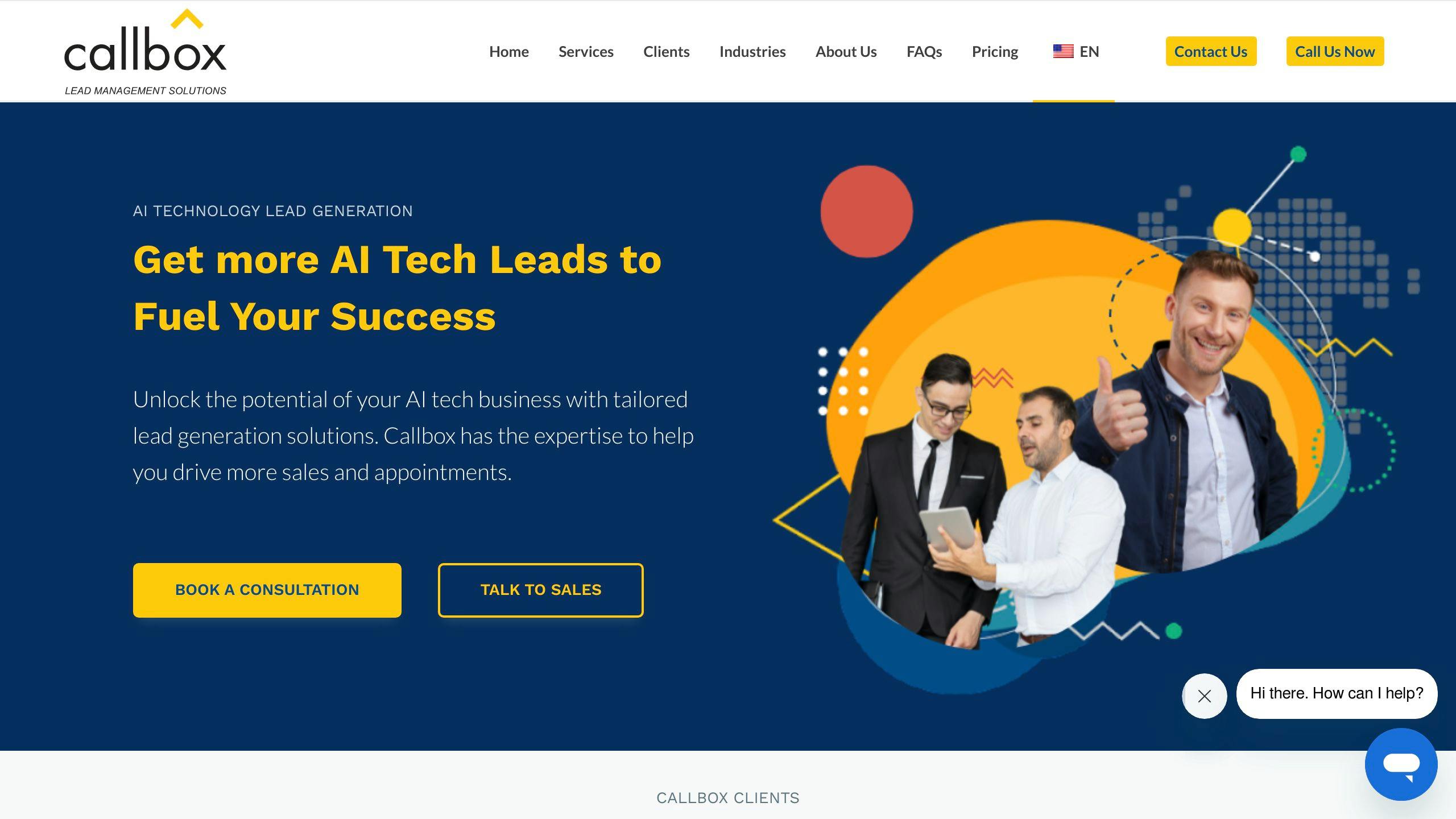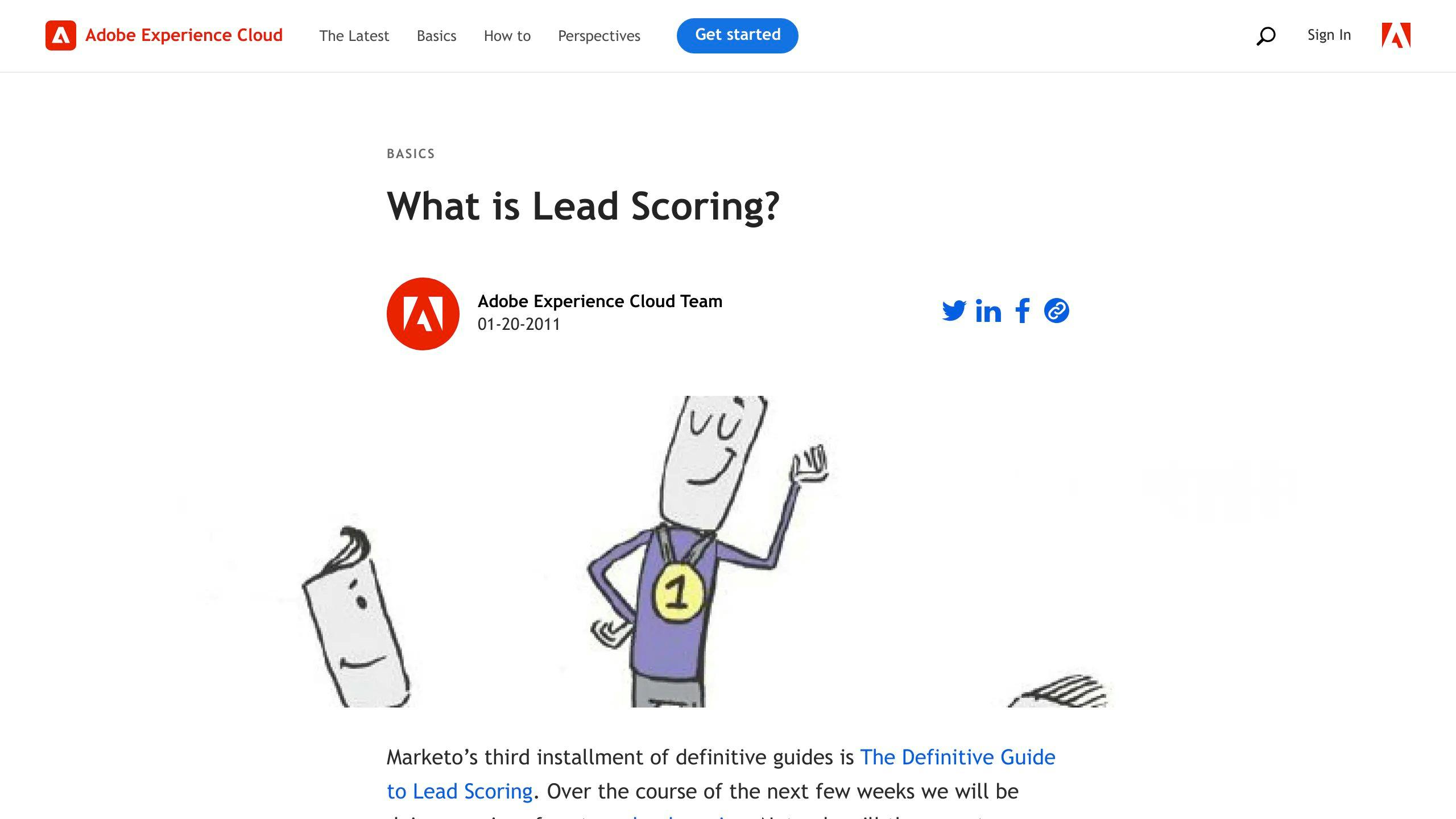March 1, 2024

Discover how AI revolutionizes lead generation for service businesses, making the process more efficient and tailored. Here's a snapshot:
By focusing on these key areas, service businesses can leverage AI to transform their lead generation processes, achieving better results with less effort.
Artificial intelligence (AI) is like a smart computer program that can do tasks we usually need a person for, such as understanding pictures, recognizing what people say, making choices, and translating languages. In finding new customers, AI helps automate boring tasks and uses data to make better decisions on who to target and how to reach out to them.
Key AI technologies used in lead gen include:

AI can help with a lot of different tasks to find and attract more customers, making the process smoother and more effective:
With AI, you're not just guessing who might be interested in what you're selling. It helps you focus on people who are more likely to buy, leading to more sales and a better return on your investment.
Using AI for getting new leads can really help businesses do better in a few key ways. It makes things more efficient, helps turn more leads into customers, and lets you reach out to more people across different places.
AI tools can take over boring tasks like putting data into systems and making lists, so your team can do more important work:
Research shows that more than half of companies are either using AI now or plan to because it makes work more efficient, especially for getting new leads.
Smart AI programs use information about customers to spot and focus on the leads that are more likely to buy:
By understanding which leads are most likely to buy and reaching out in the right way, AI helps turn more leads into customers.
AI can help you find leads in more places through chat and better targeting:
Using AI to reach out in many ways can make sales go up a lot compared to just one way. It’s something businesses of all sizes can do.
In short, AI in lead generation makes work more efficient, helps turn more leads into sales, and lets you reach more people. This can really help a business grow.
Getting AI to help with finding new customers means you need to get a few things ready first. Here's what you should do before you start using AI to get more leads:
Good data is super important for AI to work well. Before you bring AI into the mix, make sure you have:
With clean and complete data, your AI tools can really get to know your audience and tailor messages just for them.
Look at the tools you're already using for sales and marketing to see how AI can fit in. Here's what to check:
Fix any issues with your current tools and processes to make sure they're ready for AI. This makes it easier to start using AI to find new leads and see better results.
By getting these basics right, you can begin experimenting with AI to make finding new leads more efficient and effective.
Putting AI into action for finding more leads might seem tough, but if we break it down into simple steps, it's definitely something you can handle. Let's walk through the main parts - from deciding what you want to achieve to actually starting to use AI in your business.
First off, decide exactly what you want AI to help you with. Here are some goals you might think about:
When you know your goals, you can pick the right AI tools and keep on track as you start using them.
After setting your goals, look for AI software that fits what you need. Here's a quick look at some options:
ToolLead Gen CapabilitiesIdeal ForPriceLoman AIChatbots, lead scoring, campaign automationTurning web traffic into sales$99/mo - $199/moConversicaLead nurturing, qualificationBig sales teamsCustom pricingDriftChatbots, personalizationSmall businesses that know tech$50/mo - $150/mo
Pick 1 or 2 tools to try out, based on how much you can spend and what you need them to do.
For AI to work smoothly, it needs to connect with your current systems:
Step 1: Make sure your CRM is tidy and can share data with other tools.
Step 2: Plan out how a lead moves through your system - from visiting your website to getting emails and calls.
Step 3: Set up connections so information about leads moves correctly at each step.
Step 4: Let your new AI tools use your current data to better understand and interact with leads.
To make sure everyone's ready, teach your team about what AI can do:
Getting everyone on board early helps your team get the most out of AI.
Now, you're ready to start using AI! Begin with small steps like:
Watch how things are going and adjust as needed. Once it's working well, use AI for all your lead finding activities.
By taking it step by step, you can make AI a big help in getting more leads for your business. Time to let the automation do its magic!
AI lead generation uses data and smart programs to make finding new customers easier and more efficient. Here are some top strategies and examples of how they work in the real world.

Predictive lead scoring uses AI to look at customer data and give leads scores based on how likely they are to become customers. Key benefits:
For instance, a CRM system can keep track of what leads do, like opening emails, filling out forms, or visiting websites. Then, AI uses this info to give each lead a score. Salespeople can then focus on leads with higher scores first.
AI looks at customer data to create messages that are just right for each lead. This gets more people interested and helps turn them into customers. Tactics include:
A test by Salesforce found that using AI to personalize email subject lines made click-through rates go up by 2.7 times.
Looking at how prospects act over time can show if they might buy something, even if they don't right away. AI can group leads based on their actions to help figure out who to target.
For example, an AI tool might group leads who haven't bought yet based on what pages they've looked at or emails they've opened. Some might just need more information, while others who checked out pricing pages might be ready for a special offer.
Predictive analytics uses past data to guess future changes in lead numbers and quality. This helps businesses plan ahead. Metrics estimated include:
With these forecasts, teams can plan their budgets, change campaigns, and use resources better to match what's coming.
In short, AI changes the old way of finding leads into a smarter, automated process that brings in better leads. The insights from data help close more deals as well.
AI is making a big difference for many service businesses, helping them find more customers and sell more. Here are a few stories of companies that have seen great results with AI.
HomeHero offers help at home for older adults. They used AI chatbots and smart emails to talk to more potential customers and got 5 times more sales.
"AI made it easier for us to sort leads and speed up sales." - Sarah D, Director of Sales
GoodMotion fixes cars across the country. With AI, they cut the cost of finding new customers by 10%.
"AI lets us talk to the right people and turn chats into sales." - Troy G, VP of Marketing
SolarBright puts solar panels on buildings. AI helped them get 20% more leads ready to buy in just a year.
"AI takes care of the routine tasks, so we can focus on real conversations that lead to sales." - Miranda S, Sales Manager
In summary, AI is helping lots of service companies do better by finding the right leads and making more sales. The success stories show it works!
To really understand if your AI efforts to get more leads are paying off, it's important to keep an eye on certain numbers and tweak your approach based on what you find. Here's a simple guide to help you do just that.
Think of reporting dashboards as your command center for checking how things are going. You'll want to see:
Make sure these dashboards pull in data automatically from your AI tools, your customer management system, website analytics, and anywhere else relevant. Take a look at these dashboards often to spot any patterns.
Dive into each of your campaigns to see what's hitting the mark and what might be missing it. Look at things like:
Compare these numbers to what you were hoping to achieve and to how you've done in the past. This can show you where AI is making a difference and where you might need to make some changes.
Check if your overall efforts to get more leads are on track by looking at:
If you're not hitting your targets, use the data to figure out what's not working.
Based on what the data tells you, keep tweaking your approach to get better results:
Make it a habit to regularly check in on your results and adjust your plan as needed. Remember, fine-tuning your approach is an ongoing process!
Keeping track of how things are going and making adjustments based on real data is key to making the most of AI in getting more leads. By following this guide, you can increase your leads and sales over time.
When you start using AI for finding new customers, you might run into some bumps along the way. Knowing about these problems and how to fix them will help you move past them smoothly. Here are some usual issues and tips on how to deal with them:
AI needs good data to make smart choices. But sometimes, data can be messy or unfair:
Solutions:
Sometimes, it's hard to understand how AI makes its decisions:
Solutions:
Relying too much on AI can sometimes cause problems:
Solutions:
By knowing these tips, you can avoid big problems with AI. Being prepared to fix issues helps build trust and success.
AI is getting better and better, making it easier for businesses to find and connect with potential customers. This means companies can talk to the right people more effectively and efficiently than ever before.
AI is learning to understand customer behavior and preferences better. This means businesses can:
By 2025, AI is expected to shape almost all customer experiences. Businesses that start using these AI tools now will be ahead of the game.
AI will help businesses reach potential customers through more channels:
As new ways to connect with customers pop up, AI will help businesses keep up and make sure they don't miss out on opportunities.
Expect to see all-in-one AI platforms that fit right into the tools businesses already use. These platforms will:
This means businesses can use AI more easily, making the process of finding new customers smoother.
In short, AI is changing how businesses find and win over new customers. Companies that adopt AI early will have a big advantage in reaching out to people. The future of lead generation is definitely powered by AI.
AI lead generation is changing the way service businesses find and talk to possible customers. By using smart tools like predictive analytics and personalized messages, AI makes finding leads more efficient and effective.
Here's a simple guide to help service businesses use AI:
By doing these things, service businesses can handle common AI problems like wrong data, not understanding how AI makes decisions, and using AI too much. Getting into AI for lead generation now prepares your business for new chances to connect with customers in a more personal way, reach them through different channels, and make using AI easier.
Now is the time for service businesses to start using AI for lead generation. By taking these steps, you'll change how you attract and turn quality leads into happy, long-term customers.

Enter your information in the form to receive a call from Loman and place an order like a customer would!